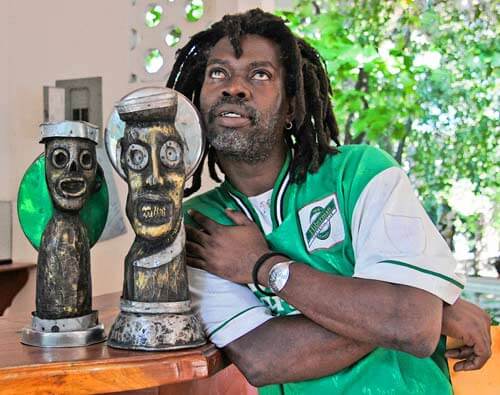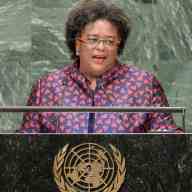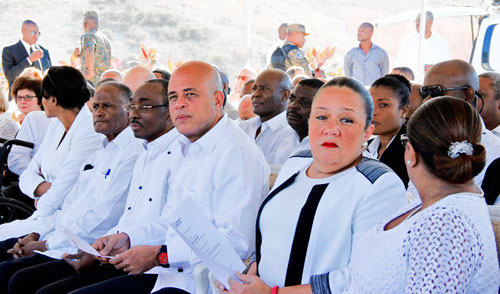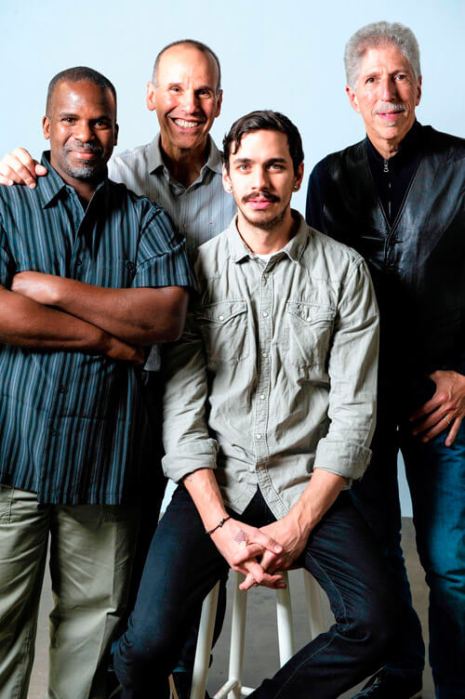The verdant grounds of the historic Oloffson Hotel are the exhibition space for fantastic sculptures by Artis Resistans, (Resistance Artists), sculptors of the Grand Rue in Port-au-Prince.
Honoring Gede, the name of the Vodou god who accompanies people from death to the next stage, the holiday falls at the beginning of November and is celebrated by visiting ancestors in the cemetery.
The Artis Resistans live or work in downtown Port-au-Prince, in the midst of auto supply and repair shops. The used and cast-off industrial materials, metal parts, hopelessly worn tires and tubes are the mediums of choice.
Following in the artistic steps of Haitian artist Nasson is master and internationally exhibited Andre Eugene exhibiting more than 10 works along with nine other artists’ on the hotel’s grounds.
Eugene was an accomplished wood sculptor when he started using cast-off industrial materials. (The downtown area was the center of wood sculptors, bowl makers, and was in close proximity to the Iron Market, a venue for sales.)
A wooden core with other cast off materials form many of his works. He explained that when he started it was easy to get the materials, but now used metals are sold to China and he needs to buy many materials.
Sculptor Claudel’s welded found-metal sculptures are some of the works one first sees on entering the grounds. The 33-year-old started making art seven years ago, inspired by Eugene and Celeur’s sculptures and encouraged by Eugene.
Claudel just returned from a six-week residency at the dump in San Francisco commenting that what he saw at the dump in the U.S. would still be used in Haiti.
Ronald Edmond’s life-size figures using animal horns and skulls gleaned from the cemetery convey Bizango (secret society) representations.
Twenty-five-year-old Theridor Davidson, the third generation of these artists and mentored at a local artist’s organization, works with tin, adding fans and other metal parts. (He also paints and mixes media, too.) His sculptures portray animals, are figurative or convey Haitian lwa (gods).
The Oloffson Gede exhibition is a prelude to a much greater event beginning end of November, the three-week Ghetto Biennale, with the sculptors of the Grand Rue.
Photographer and writer Leah Gordon and Andre Eugene started this event in 2009, with a call out to artists to come to Haiti and collaborate with the Artis Resistans.
Why do artists participate? Some just like the artwork of the sculptors of the Grand Rue. Others want to participate in a creative process with a local neighborhood. For others, the political aspects of using detrius and returning back to those where it’s from, is a strong motivation. Some build relationships with the Haitian artists, others do their art and return home. The Biennale mashes different social milieus together.
This year, 30 invited artists from N. America, Europe, and Trinidad, in the painting, sculpture, and performance arts, are participating.
After spending one to three weeks in Haiti, invited artists present their work in the neighborhood to an audience of local community people, arts collectives and organizations.
A one-day congress wraps up the Biennale, mid-December.
“We’re not here as an NGO, to have art help (in the traditional way) the Haitian people,” says organizer Gordon. “The Biennale exists for artists’ collaborations, to build networks, and to get outside of the traditional perception of Haitian art as primitive and naïve.”
Artists of the Grand Rue have exhibited in international exhibitions from Miami to Chicago and Switzerland. It is also hoped that networks formed during the Biennale will help open up the international art market to the Haitian artists.
Looking to the next generation, the Artis Resistans also sponsor classes for neighbor children – the Ti Moun Artis Resistans (Children Resistance Artists).

Photo by Tequila Minsky

























